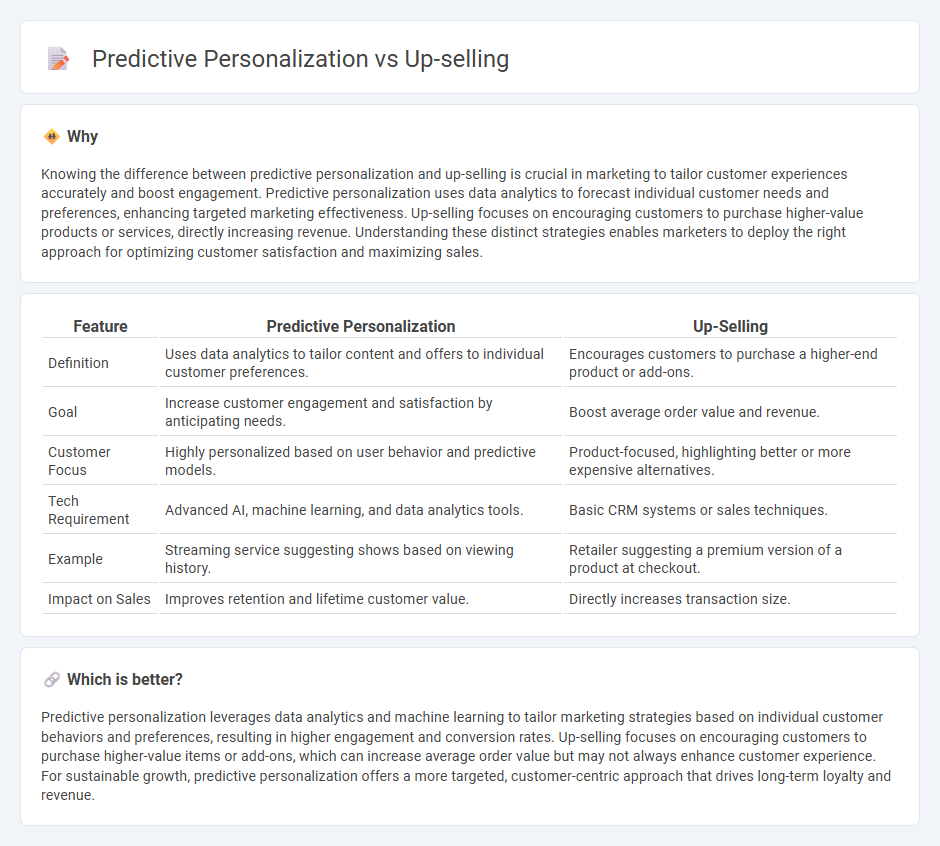
Predictive personalization leverages data analytics and machine learning to tailor marketing messages and product recommendations based on individual customer behaviors and preferences. Unlike traditional up-selling techniques that focus on promoting higher-value items, predictive personalization anticipates customer needs to enhance engagement and increase conversion rates. Discover how integrating predictive personalization can transform your marketing strategy and boost sales effectiveness.
Why it is important
Knowing the difference between predictive personalization and up-selling is crucial in marketing to tailor customer experiences accurately and boost engagement. Predictive personalization uses data analytics to forecast individual customer needs and preferences, enhancing targeted marketing effectiveness. Up-selling focuses on encouraging customers to purchase higher-value products or services, directly increasing revenue. Understanding these distinct strategies enables marketers to deploy the right approach for optimizing customer satisfaction and maximizing sales.
Comparison Table
| Feature | Predictive Personalization | Up-Selling |
|---|---|---|
| Definition | Uses data analytics to tailor content and offers to individual customer preferences. | Encourages customers to purchase a higher-end product or add-ons. |
| Goal | Increase customer engagement and satisfaction by anticipating needs. | Boost average order value and revenue. |
| Customer Focus | Highly personalized based on user behavior and predictive models. | Product-focused, highlighting better or more expensive alternatives. |
| Tech Requirement | Advanced AI, machine learning, and data analytics tools. | Basic CRM systems or sales techniques. |
| Example | Streaming service suggesting shows based on viewing history. | Retailer suggesting a premium version of a product at checkout. |
| Impact on Sales | Improves retention and lifetime customer value. | Directly increases transaction size. |
Which is better?
Predictive personalization leverages data analytics and machine learning to tailor marketing strategies based on individual customer behaviors and preferences, resulting in higher engagement and conversion rates. Up-selling focuses on encouraging customers to purchase higher-value items or add-ons, which can increase average order value but may not always enhance customer experience. For sustainable growth, predictive personalization offers a more targeted, customer-centric approach that drives long-term loyalty and revenue.
Connection
Predictive personalization leverages data analytics and machine learning algorithms to anticipate customer preferences and behaviors, enabling marketers to tailor offers with high accuracy. Up-selling benefits from this approach by presenting relevant, higher-value products or services aligned with individual customer profiles, increasing conversion rates and average order value. Integrating predictive personalization into up-selling strategies enhances customer experience and maximizes revenue potential.
Key Terms
Cross-selling
Cross-selling leverages predictive personalization by analyzing customer data to recommend complementary products, enhancing revenue opportunities and customer satisfaction. Predictive models identify purchasing patterns and preferences, enabling targeted suggestions that increase the likelihood of additional sales. Explore how integrating cross-selling with predictive personalization can transform your sales strategy and boost profits.
Customer segmentation
Customer segmentation plays a crucial role in both up-selling and predictive personalization strategies by categorizing customers based on behavioral, demographic, and transactional data to target offers effectively. Up-selling leverages segments to identify customers most likely to upgrade or add products, whereas predictive personalization uses advanced algorithms to foresee customer needs and tailor recommendations in real time. Explore how integrating these approaches with refined segmentation can drive higher engagement and revenue.
Recommendation algorithms
Up-selling leverages recommendation algorithms to suggest higher-value or premium products based on customer purchase patterns, aiming to increase average order value. Predictive personalization uses machine learning models to forecast individual preferences and behaviors, delivering tailored product recommendations that enhance customer experience and engagement. Explore how advanced recommendation algorithms can transform your marketing strategy and drive sales growth.
Source and External Links
Upselling - Wikipedia - Upselling is a sales technique where a seller invites the customer to purchase more expensive items, upgrades, or add-ons to generate more revenue, distinct from cross-selling which involves suggesting complementary products.
What Is Upselling? Definition, Examples, & Expert Tips - Plaky - Upselling involves offering a higher-end or upgraded product to meet customer needs better, thereby increasing sales revenue, boosting retention, and improving brand reputation.
How To Upsell: 15 Upselling Tips & Examples To Boost Revenue - Upselling means encouraging customers to buy a better or more expensive version of a product they're already interested in, increasing average order value and customer lifetime value.
 dowidth.com
dowidth.com